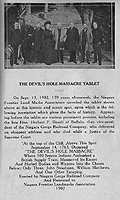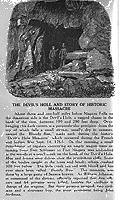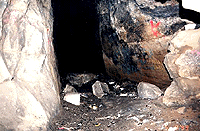
DEVIL'S HOLE
and the
DEVIL'S HOLE MASSACRE

excerpt from William's Scenic
and Historic Niagara Falls,
Edward T. Williams, Niagara Falls 1925.
Devil's Hole Ravine is located along the American shoreline of the Niagara River Gorge just north of the Niagara Glen. It is a deep, bowl shaped basin of the Bloody Run tributary from Glacial Lake Tonawanda.
After the Niagara River eroded the Niagara Gorge beyond Devils Hole, the waters of Lake Tonawanda was still draining. One of the secondary outlets was at Devils Hole where a water falls created a ravine adjacent to the wall of the Niagara Gorge.
The flow of Lake Tonawanda diminished before this infant gorge could establish itself.
The name Bloody Run recalls the massacre of British soldiers by the Seneca Indians in 1763.

excerpt from William's Scenic
and Historic Niagara Falls,
Edward T. Williams, Niagara Falls 1925.
The Legend Of Devil's Hole
On his return to Lake Ontario, LaSalle and his guide passed the huge
cavern in the cliff of the gorge, below the whirlpool, which is known today as
the Devil's Hole. LaSalle look down into it, and his guide told him that it was
the abode of the Evil Spirit. This interested LaSalle, and he proposed that at
once to descend into it. His guide, seeking to dissuade him, related to him the
following story, a tradition which has been handed down among the Seneca Indians
for generations:
"Ages and ages of prosperity and happiness to the red men had passed from the
time of his first creation. The Great Spirit loved his red children, and gave
them this country for the sole use and enjoyment. So it would have continued
forever, if the Great Falls of Onguiaahra, whose thunder, we now hear so
plainly, had continued near the spot where your canoe landed. (Lewiston). But
the red men became bad, and vexed the Great Spirit with their war parties. The
rocks began to fall off amid thunders and storms, and scarcely a moon passed
that was not marked by some change. Moons and moons passed and the falls were
above this "Devil's Hole" which then became open to the rapids, and the Evil
Spirit could get out.
Noise of thunder, shrieks and groans were often heard from his darkened den,
which greatly excited the curiosity of the young man. One of them, a fine young
brave, insisted upon examining the secrets of this dark prison house. Armed for
battle, he descended with much difficulty, and we never saw him more. Then came
the word that the pale faces, in the vast canoes which could each carry an army,
had come out of the great sea, and landed under the midday sun. The evil was
distant, and we thought little of it. Time passed on, and another of our young
men descended into the cavern; he returned in a few hours, a raving maniac, and
his hair, which had been black and glossy as a Raven had become white as snow.
Then came the word that a paleface, Jean Cabot, had landed on the shore of the
great sea, convinced that the spirit of evil lived in this deep, dark hole, and
that the fate of the red man depended upon his not being disturbed.
Such declared the guide "is the tradition of our race. Judge them, my white
brother, whether you could disturb the Evil Spirit in his abode, and not suffer
the penalty?"
LaSalle replied that he respected the Indian tradition. LaSalle had 11 men with
him when he left Montréal: presumably, all of them followed him back from the
west end of Lake Ontario to the mouth of Niagara River, and take their places
behind LaSalle, himself for the second time, and the ninth arrival of a white
man on Niagara county's soil.
A day or two later, LaSalle could no longer resist the longing to examine the
abode of the Evil Spirit. So, according to legend he returned to it, alone, and
without the knowledge of anyone, descended into it. Voices he heard and
distinct, and was led by them to the mouth of a small cave partly filled with
ice. Here a voice, in the Iroquois language, became distinct in an urgent
warning against his prosecuting his proposed discoveries in the West. "Return"
said the voice, "to your home in Canada, and wealth, honors, a long life and
usefulness will be yours, and when death comes, generations of your descendents
shall follow you to your grave, and history shall transmit your name to
prosperity as the successful founder of a great empire. Proceed to the West, and
although gleams of hope may, at times, shine in your path, in gratitude and
disappointment will be sure to meet and follow you, until a treacherous murder
shall end your days remote from human habitation, without the shelter of even a
wigwam of a friendly red man. The Eagles of the desert shall strip the flesh
from your bones, which shall lay bleaching under the tropical sun, unburied and
unprotected by the cross you now so devotedly cherish."
LaSalle heard no more, but fled out of the Devil's Hole with the utmost of most
speed, regretting that he had ignored the advice of his guide. On return to his
men, he found that some of them had deserted and started back to Montréal. This
was his first misfortune after his visit to the Devil's Hole. He proceeded to
the West. During a subsequent journeys he reached Niagara, and passed the Devils
hole again, at least 10 visits and all when he passed it for the last time, in
1683 he must have meditated how exactly every prediction made by the voice and
the Devil's Hole, 14 years before, had been fulfilled, and he must have recalled
with horror the final prediction of that voice, for he was then on his way to
France, all his fortune gone, his Indian Empire in Illinois wiped out entirely,
and he plans to secure the aid of the French court to found a colony in
Louisiana. In that attempt, the last and direct prophecy of his voice of the
Evil Spirit was destined to be fulfilled to the letter.
By the summer of 1761, the British had all but displaced the French as a military threat or political organization in North America. The British and the French were still at war with each other.
The portage routes along the Niagara Frontier were important to the military as essential supply lines and had to be protected. The job of ensuring the safe and free passage along this portage was assigned to John Stedman.
Stedman had been named "Master of the Portage" by British General - Sir William Johnson. With his assignment, Stedman was given the task of reorganizing the methods of transporting material along the portage of the Niagara River including the difficult climb at the Niagara Escarpment.
John Stedman was granted a large area of land as a reward for his service.
During the French rule, the local Seneca Indians were employed along the portage carrying supplies and cargo. They had the most difficult job of carrying these supplies up and down the escarpment; an area known to the Indians as "Crawl on all Fours".
During 1762, Stedman made many improvements to the portage which included the use of horses and carts. The Seneca porters objected to the arrival of the covered Conestoga wagons which soon resulted in those Seneca Indians becoming unemployed. Indian disenchantment soon followed.
The Niagara Portage was a vital transportation link for supplies and troops being sent to forts throughout the Upper Great Lakes in order to suppress the raids against British garrisons by the Indians as directed by Seneca Indian Chief, Pontiac.
Chief Pontiac had claimed to have had a recent meeting with the "Master of Life". The Master of Life deplored the Indians dependence upon the white man and urged all those who believed to enter into a crusade to drive the white man out. Some segments of the Indian Nation immediately began their crusade while other such as the Seneca in Niagara were much less convinced in light of their employment by the French and then the British.
During the summer of 1763, Pontiac's warriors attacked many British outposts in the Upper Great Lakes region. The importance of the Niagara portage as a troop and supply line became all the more essential for the success of the British in repelling the Indian uprisings.
Throughout the summer and fall months of 1763, the Seneca Indians often harassed the supply convoys along the Niagara portage.
On September 14th 1763, John Stedman was leading one such supply convoy which was traveling southward along the overhanging ledge along the Niagara Gorge that the Seneca Indians called Devil's Hole. This rock dome formed what was actually the roof of a cave below.
Devil's Hole was located approximately 4 miles down river from the Falls and is marked by a steep incline along the portage route.
As Stedman reached the center of the Devil's Hole crossing, he heard the yells of Seneca Indians from his left. At that same moment, a volley of flaming arrows attacked the wagon train. Five hundred Seneca Indians quickly overwhelmed the supply train, killing all in their way. Stedman sped away from the supply wagons and rode to safety and to get help from the troops at Fort Schlosser near the Falls. Stedman had barely escaped with his life. Stedman was one of three persons to survive. A young boy survived this brutal attack when he was thrown from an overturning supply wagon. The boy was able to hide amongst a clump of bushes to avoid being killed by the Indians. A third member of the wagon train was also able to narrowly escape the attack.
A rescue party from Fort Gray at nearby Lewis Town (located north of Devil's Hole) responded after hearing the Indian war cries. The Seneca Indians waited for the arrival of British reinforcements and sprung a similar ambush upon them as well. Not a single person survived the Indian attack.
By the time troops arrived from Fort Schlosser, they found only the dead. Victims had been scalped. Fearing a similar attack, the British quickly withdrew to Fort Schlosser.
After several days, the British troops returned to the site of the Devil's Hole Massacre. Here they counted 80 dead bodies. Many of the bodies had been thrown into the gorge by the Indians following the ambush.
Not long after the massacre, Sir William Johnson was informed that the massacre was arranged by "Farmer's Brother", a young Seneca Indian warrior and his followers who sympathized with Pontiac's ideology. Others speculated that it was a Seneca Indian uprising in general.
The Seneca Indians realized their mistake in ambushing the British at Devil's Hole. Instead of chasing the British from Niagara, the British entrenched and reinforced their presence.
In August of 1764, in order to make amends with the British, the Seneca Indians ceded to the British a four mile wide strip of land along the east side of the Niagara River from Lake Ontario to Lake Erie. In addition, the Seneca Indians also ceded all the islands upstream of the Falls to Sir William Johnson.

The Limestone Cave at Devil's
Hole - the Cave of the Evil Spirit
The Inside View of the Limestone Cave at Devil's
Hole
measuring approx. 42 feet in depth
courtesy of Scott A. Ensminger
The "Cave of the Evil Spirit" was named by the early Indians who foretold subsequent disaster to any one who dared enter the cave. LaSalle in 1679, in spite of this warning entered it and to this trip the Indians attributed his subsequent misfortunes and murder all within the following two years.
| NIAGARA FALLS THUNDER ALLEY NAVIGATOR | ||
| SITE MAP | ||
Date last updated:
February 20, 2012
The preceding locations and facts about them are but a few of many famous sites & attractions to be found in Niagara Falls. The best of it is FREE to see...so think of Niagara Falls when planning your next vacation. If you have questions of a current or historical nature about the Niagara Falls area or suggestions feel free to e-mail Rick at:
THANK YOU FOR VISITING THE
DEVILS HOLE
&
DEVILS HOLE MASSACRE
PAGE